Hyundai Nexo 2019 Owner's Manual
Manufacturer: HYUNDAI, Model Year: 2019, Model line: Nexo, Model: Hyundai Nexo 2019Pages: 560, PDF Size: 24.2 MB
Page 541 of 560
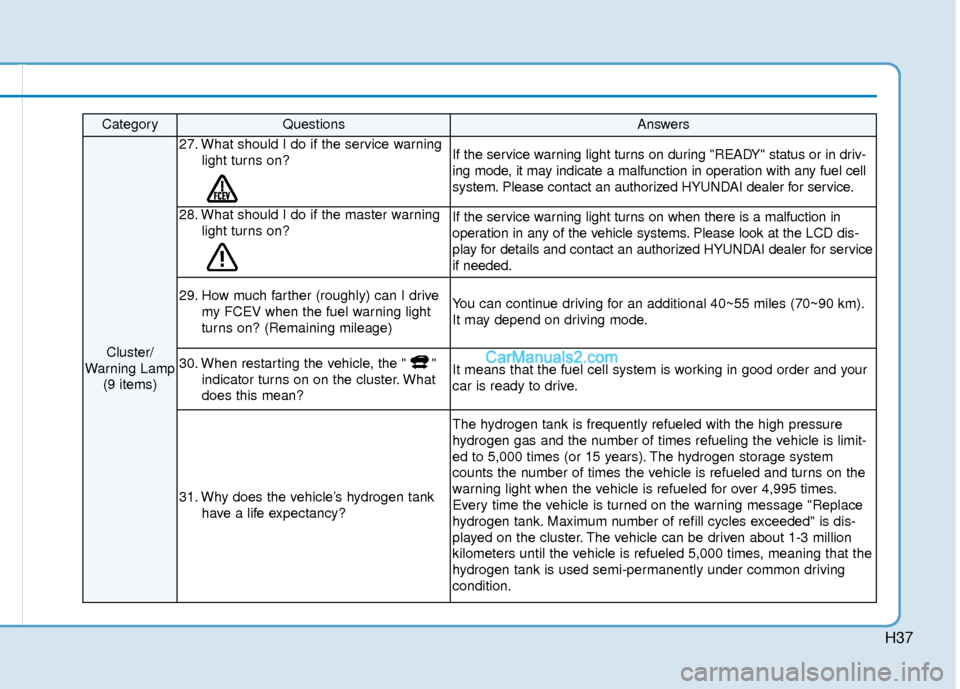
H37
CategoryQuestionsAnswers
Cluster/
Warning Lamp (9 items)
27. What should I do if the service warning light turns on?If the service warning light turns on during "READY" status or in driv-
ing mode, it may indicate a malfunction in operation with any fuel cell
system. Please contact an authorized HYUNDAI dealer for service.
28. What should I do if the master warninglight turns on?If the service warning light turns on when there is a malfuction in
operation in any of the vehicle systems. Please look at the LCD dis-
play for details and contact an authorized HYUNDAI dealer for service
if needed.
29. How much farther (roughly) can I drivemy FCEV when the fuel warning light
turns on? (Remaining mileage)You can continue driving for an additional 40~55 miles (70~90 km).
It may depend on driving mode.
30. When restarting the vehicle, the " "indicator turns on on the cluster. What
does this mean?It means that the fuel cell system is working in good order and your
car is ready to drive.
31. Why does the vehicle’s hydrogen tankhave a life expectancy?
The hydrogen tank is frequently refueled with the high pressure
hydrogen gas and the number of times refueling the vehicle is limit-
ed to 5,000 times (or 15 years). The hydrogen storage system
counts the number of times the vehicle is refueled and turns on the
warning light when the vehicle is refueled for over 4,995 times.
Every time the vehicle is turned on the warning message "Replace
hydrogen tank. Maximum number of refill cycles exceeded" is dis-
played on the cluster. The vehicle can be driven about 1-3 million
kilometers until the vehicle is refueled 5,000 times, meaning that the
hydrogen tank is used semi-permanently under common driving
condition.
Page 542 of 560
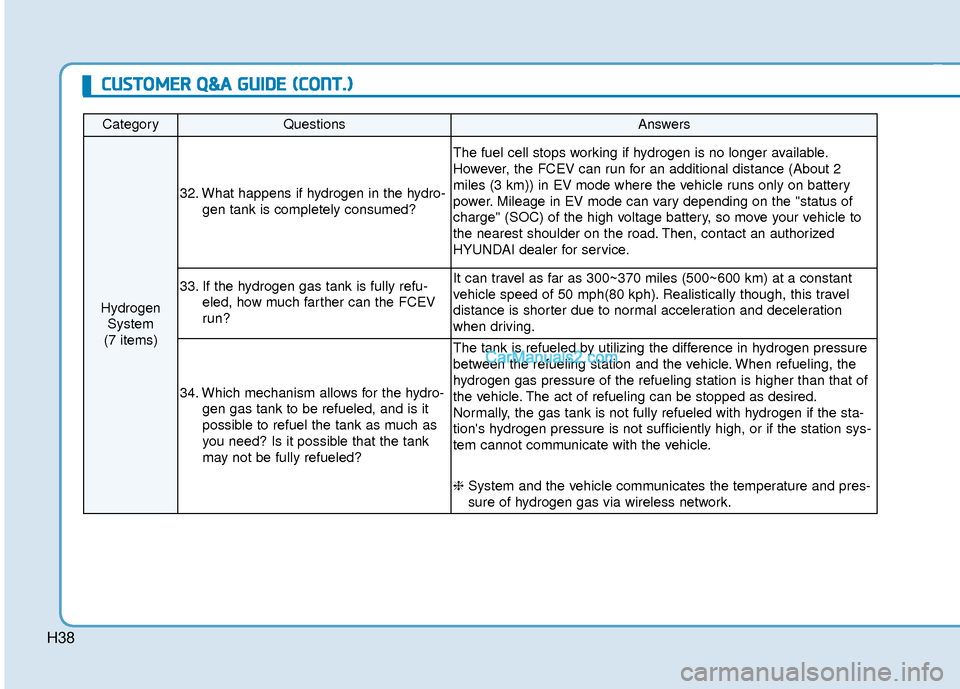
H38
CategoryQuestionsAnswers
HydrogenSystem
(7 items)
32. What happens if hydrogen in the hydro- gen tank is completely consumed?
The fuel cell stops working if hydrogen is no longer available.
However, the FCEV can run for an additional distance (About 2
miles (3 km)) in EV mode where the vehicle runs only on battery
power. Mileage in EV mode can vary depending on the "status of
charge" (SOC) of the high voltage battery, so move your vehicle to
the nearest shoulder on the road. Then, contact an authorized
HYUNDAI dealer for service.
33. If the hydrogen gas tank is fully refu-eled, how much farther can the FCEV
run?It can travel as far as 300~370 miles (500~600 km) at a constant
vehicle speed of 50 mph(80 kph). Realistically though, this travel
distance is shorter due to normal acceleration and deceleration
when driving.
34. Which mechanism allows for the hydro-gen gas tank to be refueled, and is it
possible to refuel the tank as much as
you need? Is it possible that the tank
may not be fully refueled?
The tank is refueled by utilizing the difference in hydrogen pressure
between the refueling station and the vehicle. When refueling, the
hydrogen gas pressure of the refueling station is higher than that of
the vehicle. The act of refueling can be stopped as desired.
Normally, the gas tank is not fully refueled with hydrogen if the sta-
tion's hydrogen pressure is not sufficiently high, or if the station sys-
tem cannot communicate with the vehicle.
❈System and the vehicle communicates the temperature and pres-
sure of hydrogen gas via wireless network.
C CU
U S
ST
T O
O M
M E
ER
R
Q
Q &
&A
A
G
G U
U I
ID
D E
E
(
( C
C O
O N
NT
T.
.)
)
Page 543 of 560
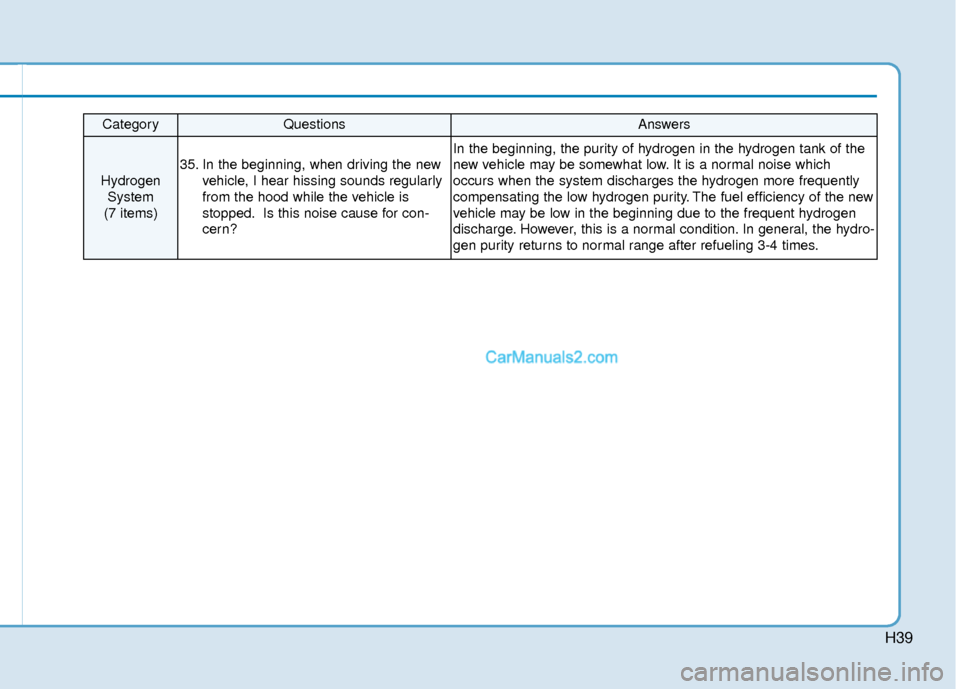
H39
CategoryQuestionsAnswers
HydrogenSystem
(7 items)
35. In the beginning, when driving the new vehicle, I hear hissing sounds regularly
from the hood while the vehicle is
stopped. Is this noise cause for con-
cern?
In the beginning, the purity of hydrogen in the hydrogen tank of the
new vehicle may be somewhat low. It is a normal noise which
occurs when the system discharges the hydrogen more frequently
compensating the low hydrogen purity. The fuel efficiency of the new
vehicle may be low in the beginning due to the frequent hydrogen
discharge. However, this is a normal condition. In general, the hydro-
gen purity returns to normal range after refueling 3-4 times.
Page 544 of 560
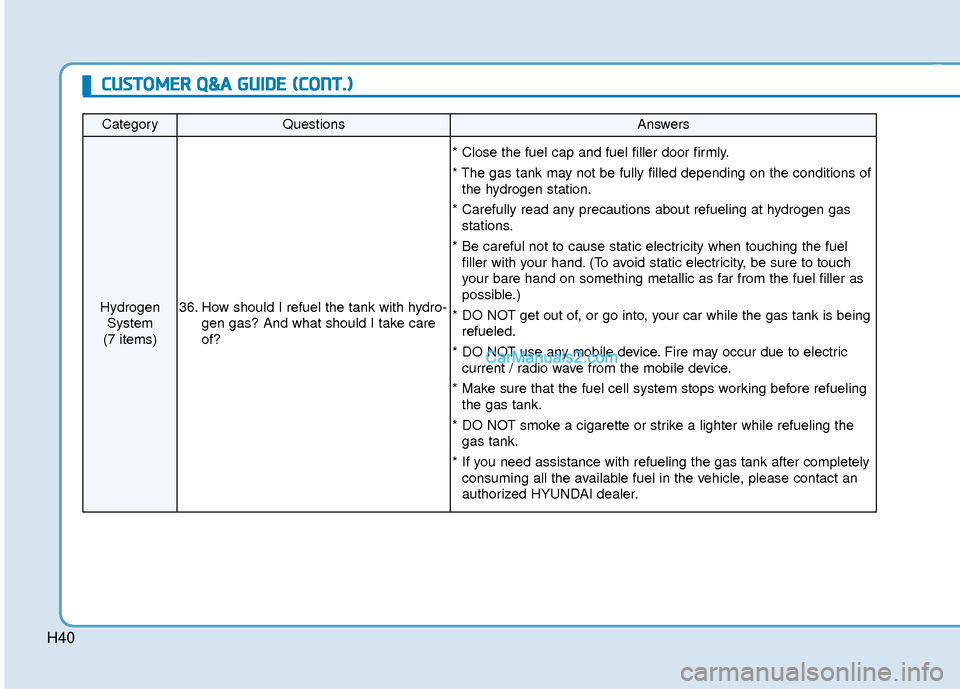
H40
C
CU
U S
ST
T O
O M
M E
ER
R
Q
Q &
&A
A
G
G U
U I
ID
D E
E
(
( C
C O
O N
NT
T.
.)
)
CategoryQuestionsAnswers
Hydrogen
System
(7 items)36. How should I refuel the tank with hydro- gen gas? And what should I take care
of?
* Close the fuel cap and fuel filler door firmly.
* The gas tank may not be fully filled depending on the conditions ofthe hydrogen station.
* Carefully read any precautions about refueling at hydrogen gas stations.
* Be careful not to cause static electricity when touching the fuel filler with your hand. (To avoid static electricity, be sure to touch
your bare hand on something metallic as far from the fuel filler as
possible.)
* DO NOT get out of, or go into, your car while the gas tank is being refueled.
* DO NOT use any mobile device. Fire may occur due to electric current / radio wave from the mobile device.
* Make sure that the fuel cell system stops working before refueling the gas tank.
* DO NOT smoke a cigarette or strike a lighter while refueling the gas tank.
* If you need assistance with refueling the gas tank after completely consuming all the available fuel in the vehicle, please contact an
authorized HYUNDAI dealer.
Page 545 of 560
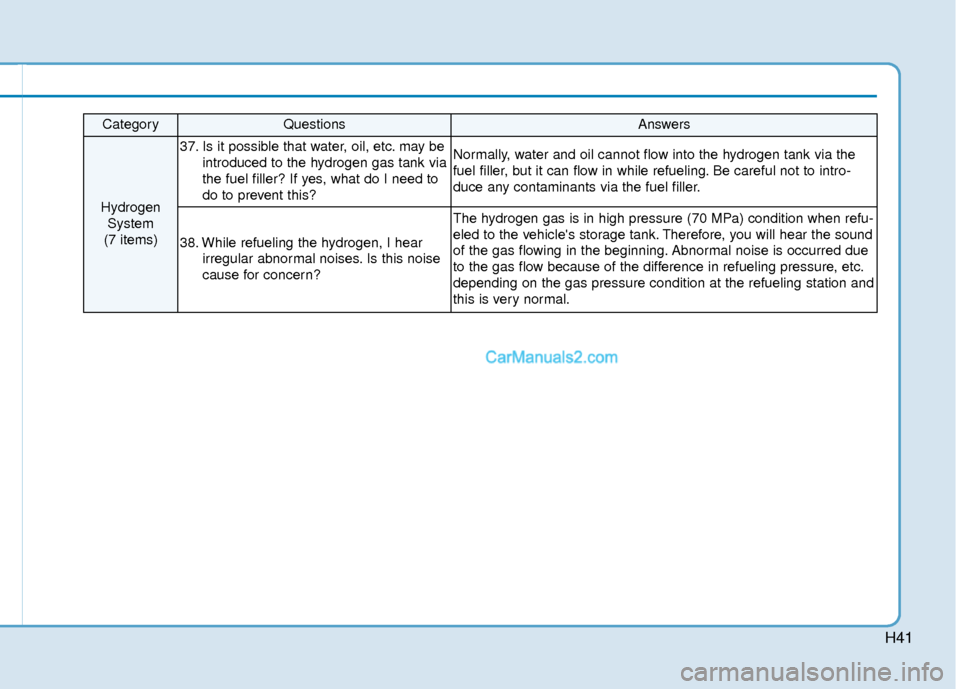
H41
CategoryQuestionsAnswers
HydrogenSystem
(7 items)
37. Is it possible that water, oil, etc. may be introduced to the hydrogen gas tank via
the fuel filler? If yes, what do I need to
do to prevent this?Normally, water and oil cannot flow into the hydrogen tank via the
fuel filler, but it can flow in while refueling. Be careful not to intro-
duce any contaminants via the fuel filler.
38. While refueling the hydrogen, I hearirregular abnormal noises. Is this noise
cause for concern?
The hydrogen gas is in high pressure (70 MPa) condition when refu-
eled to the vehicle's storage tank. Therefore, you will hear the sound
of the gas flowing in the beginning. Abnormal noise is occurred due
to the gas flow because of the difference in refueling pressure, etc.
depending on the gas pressure condition at the refueling station and
this is very normal.
Page 546 of 560
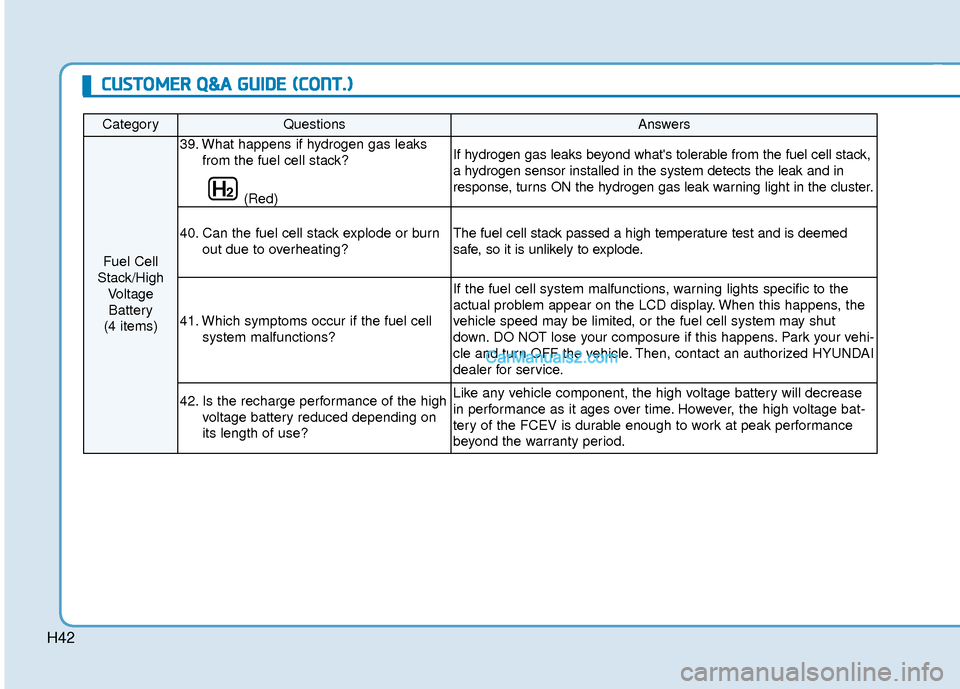
H42
CategoryQuestionsAnswers
Fuel Cell
Stack/High VoltageBattery
(4 items)
39. What happens if hydrogen gas leaks from the fuel cell stack?
(Red)If hydrogen gas leaks beyond what's tolerable from the fuel cell stack,
a hydrogen sensor installed in the system detects the leak and in
response, turns ON the hydrogen gas leak warning light in the cluster.
40. Can the fuel cell stack explode or burnout due to overheating?The fuel cell stack passed a high temperature test and is deemed
safe, so it is unlikely to explode.
41. Which symptoms occur if the fuel cellsystem malfunctions?
If the fuel cell system malfunctions, warning lights specific to the
actual problem appear on the LCD display. When this happens, the
vehicle speed may be limited, or the fuel cell system may shut
down. DO NOT lose your composure if this happens. Park your vehi-
cle and turn OFF the vehicle. Then, contact an authorized HYUNDAI
dealer for service.
42. Is the recharge performance of the highvoltage battery reduced depending on
its length of use? Like any vehicle component, the high voltage battery will decrease
in performance as it ages over time. However, the high voltage bat-
tery of the FCEV is durable enough to work at peak performance
beyond the warranty period.
C CU
U S
ST
T O
O M
M E
ER
R
Q
Q &
&A
A
G
G U
U I
ID
D E
E
(
( C
C O
O N
NT
T.
.)
)
Page 547 of 560
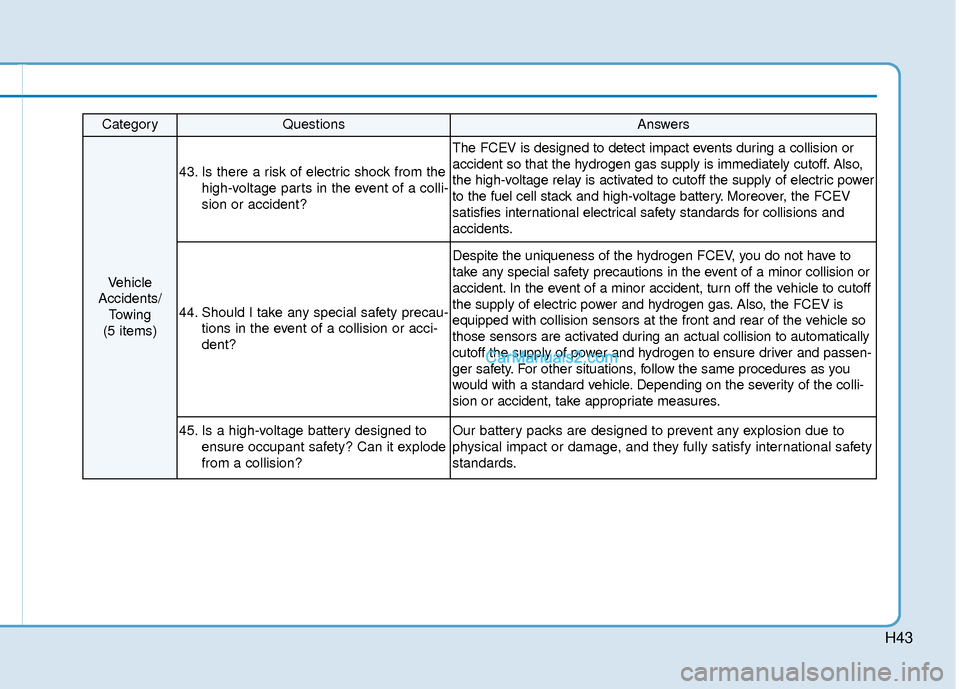
H43
CategoryQuestionsAnswers
Vehicle
Accidents/ Towing
(5 items)
43. Is there a risk of electric shock from the high-voltage parts in the event of a colli-
sion or accident?
The FCEV is designed to detect impact events during a collision or
accident so that the hydrogen gas supply is immediately cutoff. Also,
the high-voltage relay is activated to cutoff the supply of electric power
to the fuel cell stack and high-voltage battery. Moreover, the FCEV
satisfies international electrical safety standards for collisions and
accidents.
44. Should I take any special safety precau-tions in the event of a collision or acci-
dent?
Despite the uniqueness of the hydrogen FCEV, you do not have to
take any special safety precautions in the event of a minor collision or
accident. In the event of a minor accident, turn off the vehicle to cutoff
the supply of electric power and hydrogen gas. Also, the FCEV is
equipped with collision sensors at the front and rear of the vehicle so
those sensors are activated during an actual collision to automatically
cutoff the supply of power and hydrogen to ensure driver and passen-
ger safety. For other situations, follow the same procedures as you
would with a standard vehicle. Depending on the severity of the colli-
sion or accident, take appropriate measures.
45. Is a high-voltage battery designed toensure occupant safety? Can it explode
from a collision?Our battery packs are designed to prevent any explosion due to
physical impact or damage, and they fully satisfy international safety
standards.
Page 548 of 560
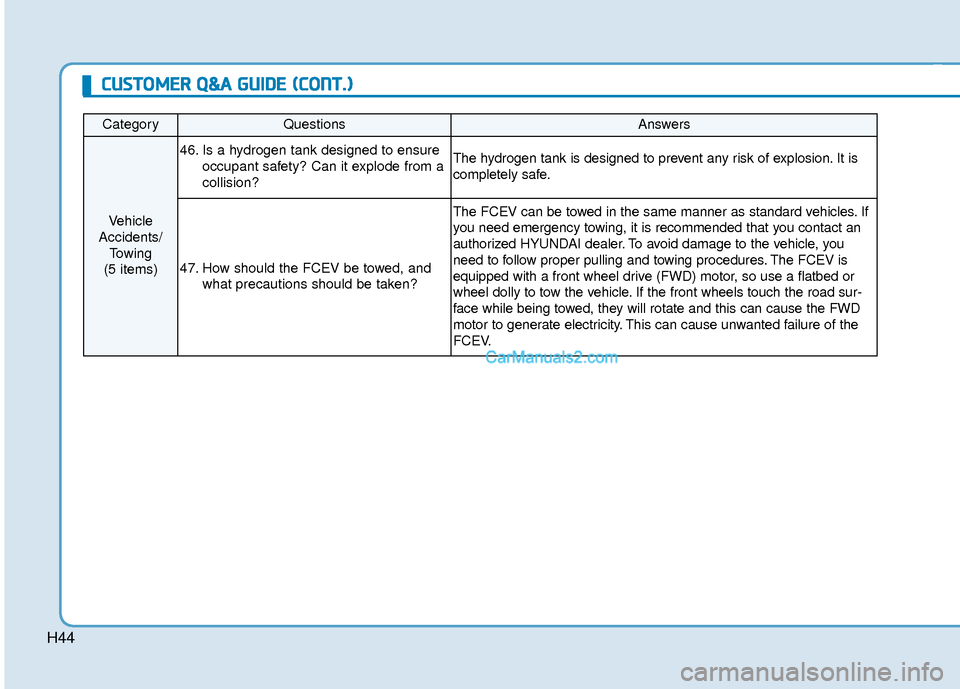
H44
CategoryQuestionsAnswers
Vehicle
Accidents/ Towing
(5 items)
46. Is a hydrogen tank designed to ensure occupant safety? Can it explode from a
collision?The hydrogen tank is designed to prevent any risk of explosion. It is
completely safe.
47. How should the FCEV be towed, andwhat precautions should be taken?
The FCEV can be towed in the same manner as standard vehicles. If
you need emergency towing, it is recommended that you contact an
authorized HYUNDAI dealer. To avoid damage to the vehicle, you
need to follow proper pulling and towing procedures. The FCEV is
equipped with a front wheel drive (FWD) motor, so use a flatbed or
wheel dolly to tow the vehicle. If the front wheels touch the road sur-
face while being towed, they will rotate and this can cause the FWD
motor to generate electricity. This can cause unwanted failure of the
FCEV.
C CU
U S
ST
T O
O M
M E
ER
R
Q
Q &
&A
A
G
G U
U I
ID
D E
E
(
( C
C O
O N
NT
T.
.)
)
Page 549 of 560
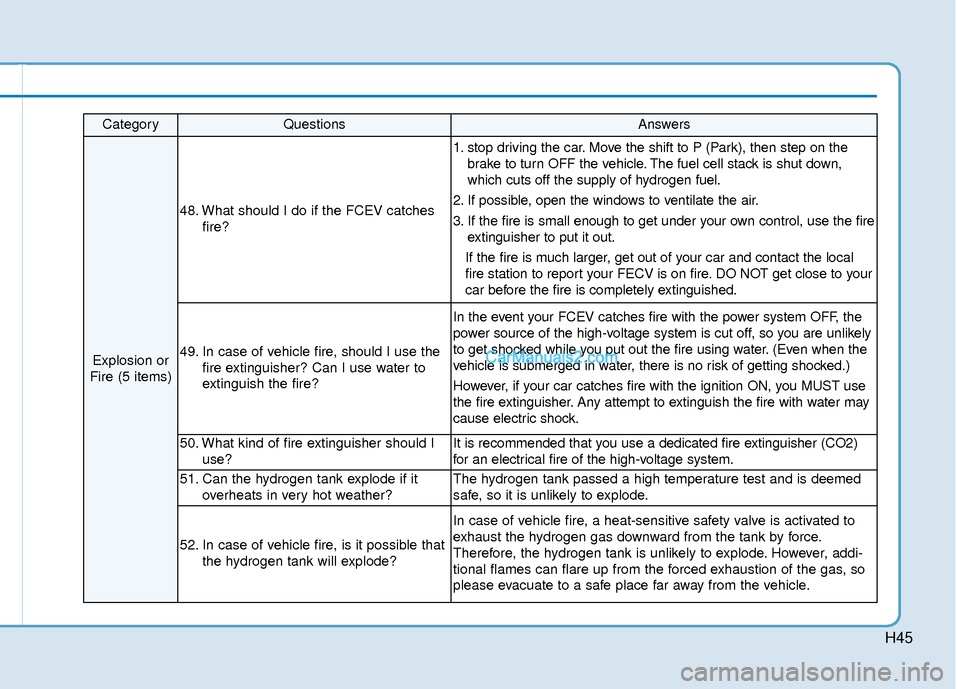
H45
CategoryQuestionsAnswers
Explosion or
Fire (5 items)
48. What should I do if the FCEV catches fire?
1. stop driving the car. Move the shift to P (Park), then step on thebrake to turn OFF the vehicle. The fuel cell stack is shut down,
which cuts off the supply of hydrogen fuel.
2. If possible, open the windows to ventilate the air.
3. If the fire is small enough to get under your own control, use the fire extinguisher to put it out.
If the fire is much larger, get out of your car and contact the local
fire station to report your FECV is on fire. DO NOT get close to your
car before the fire is completely extinguished.
49. In case of vehicle fire, should I use the fire extinguisher? Can I use water to
extinguish the fire?
In the event your FCEV catches fire with the power system OFF, the
power source of the high-voltage system is cut off, so you are unlikely
to get shocked while you put out the fire using water. (Even when the
vehicle is submerged in water, there is no risk of getting shocked.)
However, if your car catches fire with the ignition ON, you MUST use
the fire extinguisher. Any attempt to extinguish the fire with water may
cause electric shock.
50. What kind of fire extinguisher should Iuse?It is recommended that you use a dedicated fire extinguisher (CO2)
for an electrical fire of the high-voltage system.
51. Can the hydrogen tank explode if itoverheats in very hot weather?The hydrogen tank passed a high temperature test and is deemed
safe, so it is unlikely to explode.
52. In case of vehicle fire, is it possible thatthe hydrogen tank will explode?
In case of vehicle fire, a heat-sensitive safety valve is activated to
exhaust the hydrogen gas downward from the tank by force.
Therefore, the hydrogen tank is unlikely to explode. However, addi-
tional flames can flare up from the forced exhaustion of the gas, so
please evacuate to a safe place far away from the vehicle.
Page 550 of 560
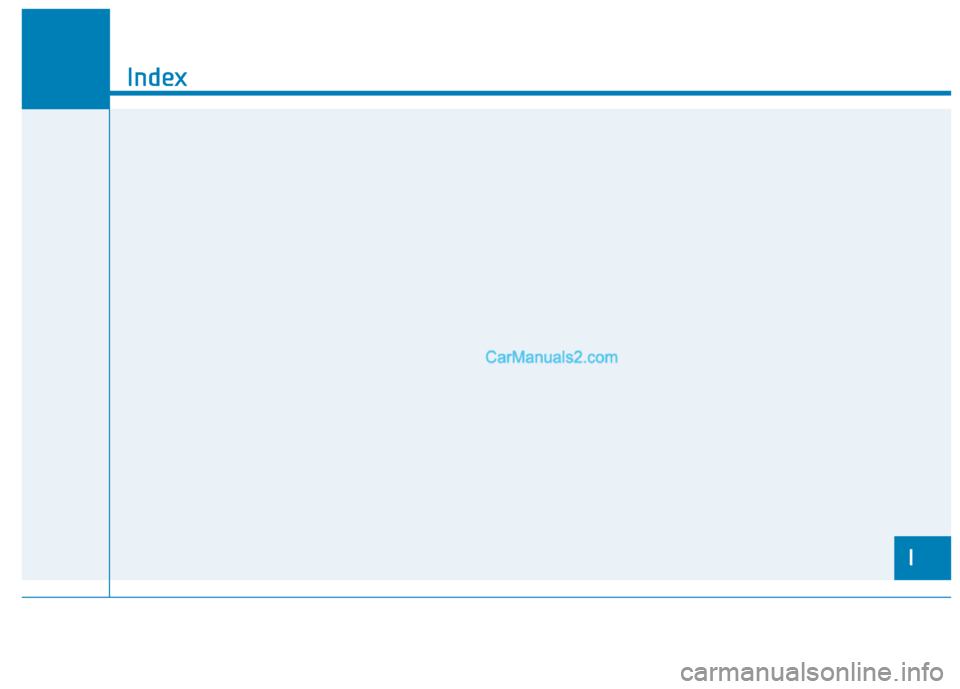
I
Index
I